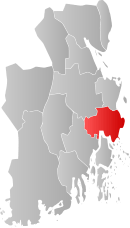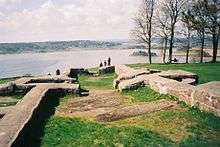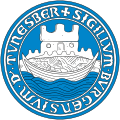Tønsberg
| Tønsberg kommune | |||
|---|---|---|---|
| Municipality | |||
|
Tønsberg | |||
| |||
 Tønsberg within Vestfold | |||
| Coordinates: 59°17′53″N 10°25′25″E / 59.29806°N 10.42361°ECoordinates: 59°17′53″N 10°25′25″E / 59.29806°N 10.42361°E | |||
| Country | Norway | ||
| County | Vestfold | ||
| District | Viken, Norway | ||
| Administrative centre | Tønsberg | ||
| Government | |||
| • Mayor (2009) | Petter Berg (H) | ||
| Area | |||
| • Total | 107 km2 (41 sq mi) | ||
| • Land | 106 km2 (41 sq mi) | ||
| Area rank | 381 in Norway | ||
| Population (2014) | |||
| • Total | 41.486 | ||
| • Rank | 21 in Norway | ||
| • Density | 367/km2 (950/sq mi) | ||
| • Change (10 years) | 10.1 % | ||
| Demonym(s) | Tønsbergenser[1] | ||
| Time zone | CET (UTC+1) | ||
| • Summer (DST) | CEST (UTC+2) | ||
| ISO 3166 code | NO-0704 | ||
| Official language form | Bokmål | ||
| Website |
www | ||
|
| |||
Tønsberg [²tønsbær] (![]() listen) is a municipality in Vestfold county, southern Norway, located around 102 kilometres (63 miles) south-southwest of Oslo on the western coast of the Oslofjord near its mouth onto the Skagerrak. The administrative centre of the municipality is the town of Tønsberg. The municipality has a population of 41,239 and covers an area of 107 square kilometres (41 square miles).
listen) is a municipality in Vestfold county, southern Norway, located around 102 kilometres (63 miles) south-southwest of Oslo on the western coast of the Oslofjord near its mouth onto the Skagerrak. The administrative centre of the municipality is the town of Tønsberg. The municipality has a population of 41,239 and covers an area of 107 square kilometres (41 square miles).
Tønsberg is generally regarded as the oldest town in Norway. Tønsberg was established as a municipality on 1 January 1838 (see formannskapsdistrikt). The rural municipality of Sem was merged into the municipality of Tønsberg on 1 January 1988.
General information
Name
The Old Norse form of the name was Túnsberg. The first element is the genitive case of tún (n), meaning fenced area or garden. The last element is berg (n), meaning mountain. The name originally referred to the fortifications on Slottsfjellet. The old spelling has been retained in the name of the diocese, Tunsberg bispedømme.
Coat of arms
The coat of arms is an old city seal from as far back as 1349. The seal shows Tønsberg Fortress surrounded by a ring wall on a mountain with the sea in front. There is also a longship in the water in front of the fortress. Around the seal are the words (in Latin): This is the seal of Tunsberg.[2]
History
The first time the town was mentioned by a contemporary writer was in 1130. According to Snorri Sturluson, Tønsberg was founded before the Battle of Hafrsfjord, which, according to Snorri, took place in 871. What year the battle took place is disputed, however, and most current historians believe the battle took place closer to 900. However, if the battle did in fact take place in 871, this would make Tønsberg the oldest present Scandinavian city. It was based upon this that the city's 1000 years jubilee was celebrated in 1871, and 1100 years jubilee in 1971. The archaeological excavations conducted in 1987–88 underneath the monastery ruins revealed several Viking graves which have served to confirm the earlier age of the original settlement.[3]
The king or his ombudsman resided in the old Royal Court at Sæheimr, today the Jarlsberg Estate (Jarlsberg Hovedgård), and on the farm Haugar, (from the Old Norse word haugr meaning hill or burial mound), which can be assumed to have been Tønsberg's birthplace. Haugar became the seat for the Haugating, the Thing for Vestfold and Norway's second most important place for the proclamation of kings. The site had probably been named after two Viking Era mounds, which tradition links to two sons of King Harald I, Olaf Haraldsson Geirstadalf, who was king in Vestfold, and his half-brother, Sigrød Haraldsson, king of Trondheim. Both are presumed to have fallen in battle at Haugar against their half-brother Eric Bloodaxe and to have been buried on the same spot.[4]
Slottsfjellet (Castle Mountain), north of the city centre, made for a near impregnable natural fortress. During the civil war era of the 12th century, it was fortified by the Baglers. The Birkebeiners besieged it for 20 weeks in the winter of 1201 before the Baglers surrendered. In the 13th century, King Haakon Haakonson set up a castle in Tønsberg, Tønsberg Fortress. The town was destroyed by fire in 1536, but Tønsberg remained one of the most important harbour towns in Norway.[5]
During the German occupation of Norway in World War II, the Berg concentration camp was constructed near Tønsberg. In 1948, Tønsberg became the cathedral city of the Diocese of Tunsberg (Tunsberg bispedømme), created when the counties of Buskerud and Vestfold were separated from the Diocese of Oslo.
Tourist sites
Perhaps the most important landmark in the town is Slottsfjellet, the tower standing on the hill. It was erected in 1888 as a memorial to Tønsberg Fortress (Tunsberg festning), the old fortress, of which just fragmentary ruins remain today. Below the mountain there is a museum dedicated to "Slottsfjellet" and Tønsberg. There are several exhibitions here about whaling and the fortress, Slottsfjellet. Several streets in the town are named after old kings of Norway.[6]

Other notable tourist sites include:
- Haugar Art Museum (Haugar Vestfold Kunstmuseum) – located in the former Seamen's School in the middle of Tønsberg, the brick building was built 1918–21. The museum was established in 1993 as a foundation created by Vestfold county and municipality of Tønsberg. The museum is a division in Vestfold County Museum Authority. Haugar Vestfold Art Museum is located in the parkland between the site of the ancient assembly of Haugating and the two Viking era mounds.[7]
- Foynegården – the city's best-preserved merchant's yard. Foynegården is the site of a patrician houses from the 1700s where Svend Foyn was born in 1809.
- Ruins of St. Olav's Church (Olavskirken) – Former monastery founded in 1191, located near the current Tønsberg Library.[8]
- Ruins of St Michael's Church (Mikaelskirken) are still visible on top of Slottsfjellet. The church was mentioned among the royal chapels. It is believed to have been destroyed in 1503 when Swedish soldiers razed fortifications.[9]
- Sem Church (Sem kirke) – Vestfold's oldest stone church built before 1100 in the Romanesque style, located near the Jarlsberg Estate[10]
- Tønsberg Cathedral (Tønsberg domkirke) – Brick church from 1858 with pulpit from 1621 and an altarpiece from 1764.[11]
- Slottsfjell festival, one of the biggest happenings in Tønsberg through the year. People all over the country come to Tønsberg to participate, this festival is one of Tønsberg newly landmarks.
Oseberghaugen
Tønsberg is the site of Oseberghaugen, a Viking era burial mound. The Oseberg ship was found in the Oseberg burial mound in 1904. This Viking era longship is now in the Viking Ship Museum in Oslo. Archaeological excavations in 1904 uncovered history's largest and richest example of craftmanship from the Viking Age. In addition to the Oseberg ship, Oseberghaugen contained the Oseberg carriage, five beautifully carved bed-posts shaped like animal heads, four sledges, beds, chests, weaving-frames, household utensils and much more. Scientific examinations in 1992 now date the burial to 834 AD, and indicate a probability that it was Queen Alvhild, the first wife of King Gudrød, who was buried here.[12]
Economy
Tønsberg is mostly a shopping town and an administrative centre. It is also noted especially for its silverware. The city is served by the railway line Vestfoldbanen, which runs in a loop through the city before reaching Tønsberg Station.
Population
| Historical population | ||
|---|---|---|
| Year | Pop. | ±% |
| 1951 | 12,208 | — |
| 1960 | 12,591 | +3.1% |
| 1970 | 11,284 | −10.4% |
| 1980 | 9,247 | −18.1% |
| 1990 | 31,275 | +238.2% |
| 2000 | 34,716 | +11.0% |
| 2010 | 39,367 | +13.4% |
| Source: Statistics Norway. Note: The municipality of Sem, Norway was merged with Tønsberg 1 January 1988. | ||
On 1 January 2009, the population of Tønsberg municipality was 38,914.[13] The population of the urban area, Norway's tenth most populous, was 46,091. 30,061 lived in Tønsberg municipality, while 16,030 lived in Nøtterøy municipality. The urban area extends from Eik in the north, to Tolvsrød, Vallø and Ringshaug in the east and Borgheim on Nøtterøy in the south. Tønsberg municipality contains four additional urban areas: Sem, with 2,147 inhabitants of which 2,100 live in Tønsberg and 47 live in Stokke; Barkåker, with 1,292 inhabitants; Åsgårdstrand, with 2,847 inhabitants of which 2,794 in Horten and 53 in Tønsberg; and Vear, with a population of 3,502 of which 2,263 live in Stokke and 1,239 live in Tønsberg.[14]
Notable residents
- Svend Foyn (1809–1910), a Norwegian shipping and whaling magnate
- Johan Sverdrup (1816–1892), liberal politician, prime minister of Norway from 1884 to 1889
- Wilhelm Wilhelmsen (1839–1910), a Norwegian shipping magnate, founder of the Wilh. Wilhelmsen Shipping Company
- Peter Christophersen (1845–1930), diplomat
- Søren Andreas Christophersen (1849–1933), diplomat
- Axel Thue (1863–1922), Norwegian American mathematician
- Ole O. Lian (1868–1925), politician, leader of the Norwegian Confederation of Trade Unions
- Halfdan M. Hanson (1884–1952), Norwegian American architect
- Hjalmar Andersen (1923–2013), three times European and World champion as well as 1952 Winter Olympics champion in speedskating
- Jahn Teigen (born 1949), singer, musician, and comedian
- Ronny Johnsen (born 1969), former professional footballer (Manchester United), lives in Tønsberg
- Anders Aukland (born 1972), the six-time winner of the world championship in cross-country skiing, born in Husvik/Tønsberg
- Lene Nystrøm (born 1973), lead vocalist of the Danish-Norwegian dance group Aqua
- Magnus Carlsen (born 1990), Norwegian chess grandmaster, World Chess Champion
- Adelén (born 1996), Norwegian singer
- Seigmen, a Norwegian alternative rock band, comes from Tønsberg.
Popular culture
Tønsberg has been featured as a location in several films:
- Captain America: The First Avenger (2011)
- Thor (2011)
Twin towns – sister cities
The following cities are twinned with Tønsberg:[15]
 Covarrubias, Spain
Covarrubias, Spain Évora, Portugal
Évora, Portugal Ísafjörður, Iceland
Ísafjörður, Iceland Joensuu, Finland
Joensuu, Finland Lamia, Greece
Lamia, Greece Linköping, Sweden
Linköping, Sweden Ravenna, Italy
Ravenna, Italy
References
- ↑ "Navn på steder og personer: Innbyggjarnamn" (in Norwegian). Språkrådet. Retrieved 2015-12-01.
- ↑ "Fakta om Tønsberg" (in Norwegian). Tønsberg kommune. Retrieved 2009-01-14.
- ↑ History of the town (County Capital Tønsberg)
- ↑ Tønsberg History (GoNorway)
- ↑ Tunsberghus (Old Tønsberg)
- ↑ Slottsfjellet og Tunsberg (Utgitt av Stiftelsen Gamle Tønsberg)
- ↑ Haugar Vestfold Art Museum (Vestfoldmuseene IKS)
- ↑ Olavsklosteret i Tønsberg (Norges klostre i middelalderen)
- ↑ "Michaelkirken". De gamle kirkene i Tønsberg. Retrieved September 1, 2016.
- ↑ Sem kirke (Kirkebygning og kirkekunst)
- ↑ Tønsberg domkirke (Norsk Folkemuseum
- ↑ Oseberghaugen – Royal mound in Tønsberg (Attractions in Tønsberg)
- ↑ "0704 Tønsberg og 0705 Tønsberg. Population 1 January and population changes during the year. 1951–" (in Norwegian). Statistics Norway. Retrieved 2007-11-30.
- ↑ "Urban settlements. Population and area, by municipality. 1 January 2007" (in Norwegian). Statistics Norway. Archived from the original on 7 November 2007. Retrieved 2007-11-30.
- ↑ "Samarbeid og prosjekter" (in Norwegian). Tønsberg kommune. Retrieved 2009-01-14.
External links
| Wikimedia Commons has media related to Tønsberg. |
| Look up Tønsberg in Wiktionary, the free dictionary. |
- Municipal fact sheet from Statistics Norway
 Vestfold travel guide from Wikivoyage
Vestfold travel guide from Wikivoyage Tønsberg travel guide from Wikivoyage
Tønsberg travel guide from Wikivoyage- Municipality website
- Tønsberg Navigasjonsskole
- Haugar Art Museum




